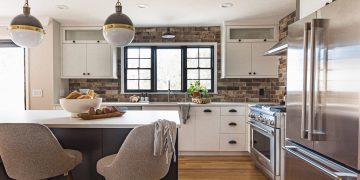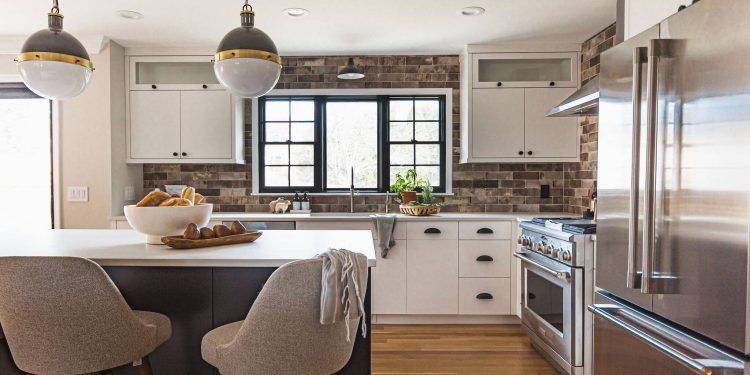Introduction: The Journey to a Kitchen Makeover
Embarking on a Transformation of the Heart of the Home
The kitchen is more than just a room for preparing meals; it’s a central hub for family gatherings, a place for sharing conversations, and a space where culinary creativity comes to life. Over time, however, even the most cherished kitchen can become outdated, less functional, or simply out of sync with the homeowner’s evolving lifestyle and tastes. This is where the idea of a kitchen makeover comes into play, offering an opportunity to reinvent this essential space.
In this article, we will explore the journey of a kitchen makeover, from the initial realization that change is needed to the joyous unveiling of a transformed cooking space. This process is not just about upgrading appliances or refreshing the decor; it’s a comprehensive reimagining of one of the most important rooms in a home. We will discuss how to identify the need for a makeover, set realistic goals, select the right materials, and manage the challenges that come with such a significant renovation.
Whether the aim is to create a more efficient workspace, to infuse new life into the home’s aesthetic, or to incorporate the latest in kitchen technology, a makeover can significantly enhance the experience of cooking and socializing in the kitchen. For those considering a kitchen transformation, this article aims to provide valuable insights, practical advice, and inspiration to embark on this rewarding journey.
Realizing the Need for Change
Identifying What’s Missing in Your Current Kitchen
The first step in any kitchen makeover is recognizing that your current space no longer meets your needs or desires. This realization often stems from various factors that highlight the inadequacies of the existing kitchen.
Functionality Limitations: A common trigger for a kitchen makeover is functionality. This could be a lack of storage, insufficient counter space, or an inconvenient layout that hampers cooking activities and social interaction within the kitchen.
Outdated Style: Style preferences evolve, and a kitchen that once seemed perfect might now feel dated or out of sync with the rest of your home. An aesthetic mismatch can diminish the overall appeal and ambiance of the space.
Wear and Tear: Over time, signs of wear and tear such as peeling countertops, faded cabinets, and outdated appliances can detract from the kitchen’s look and functionality, signaling the need for an upgrade.
Changing Lifestyle Needs: A kitchen suitable for a single person or a couple might not suffice for a growing family. Similarly, an increase in entertaining at home might necessitate a more open and inviting kitchen layout.
Recognizing these signs and understanding your specific needs sets the foundation for a successful kitchen makeover. It allows you to tailor the renovation process to address practical issues and aesthetic desires, ensuring the end result is a kitchen that is not only beautiful but also highly functional and attuned to your lifestyle.
Setting Goals and Design Vision
Crafting a Blueprint for Your Dream Kitchen
Once the need for a kitchen makeover is established, the next step is setting clear goals and developing a design vision. This stage is crucial for guiding the renovation process and ensuring the final outcome aligns with your expectations and lifestyle.
Defining Your Goals: Start by outlining what you want to achieve with the makeover. Are you looking to increase storage space, improve the layout for better functionality, update the kitchen’s look, or integrate modern appliances and technology? Defining these goals helps in creating a focused renovation plan.
Creating a Design Vision: Consider the style, color scheme, and overall ambiance you desire for your new kitchen. Whether it’s a sleek, modern look, a cozy, traditional feel, or something in between, your design vision will guide every decision from cabinetry to countertops to fixtures.
Functionality Meets Aesthetics: Balance aesthetics with practicality. The kitchen needs to be visually appealing, but it also has to cater to your cooking habits and lifestyle needs. Think about the placement of appliances, the work triangle, and the flow of movement within the kitchen.
Incorporating Personal Preferences: Personalize your kitchen to reflect your taste and preferences. This could be through unique backsplashes, custom cabinetry, distinctive lighting fixtures, or decorative elements that add character to the space.
Seeking Professional Input: Depending on the scope of your makeover, consider consulting with a kitchen designer or architect. These professionals can offer valuable insights, innovative solutions, and help in translating your vision into a practical, achievable design.
By setting clear goals and developing a detailed design vision, you lay the groundwork for a kitchen makeover that not only enhances the aesthetics and value of your home but also enriches your daily life through improved functionality and personalization.
Choosing Materials and Appliances Wisely
Selecting the Building Blocks of Your Kitchen Makeover
The choice of materials and appliances plays a pivotal role in the success of a kitchen makeover. These elements not only define the look of your kitchen but also its functionality and longevity.
Materials for Durability and Style: When selecting materials for countertops, cabinetry, flooring, and backsplashes, consider both durability and aesthetic appeal. For instance, granite or quartz countertops are popular for their resilience and elegance, while hardwood or tile flooring offers durability along with a range of design options.
Cabinetry That Fits Your Needs: The cabinetry should reflect your style and meet your storage needs. Custom cabinets can be designed to fit specific dimensions and preferences, while modular options offer a more cost-effective solution without compromising on style.
Appliances for Efficiency and Comfort: Modern appliances significantly contribute to the efficiency of a kitchen. Choose energy-efficient models that fit your cooking style and kitchen layout. High-quality appliances may represent a higher initial investment but can offer better performance and longevity.
Backsplashes and Accent Materials: A backsplash can be a statement piece in your kitchen, adding color and personality. Choose materials that complement the countertops and cabinetry while also being easy to clean and maintain.
Lighting and Hardware: Don’t overlook the importance of lighting and hardware. These elements can tie the kitchen together, adding functionality and enhancing the overall design. Consider task lighting for work areas and ambient lighting for a warm atmosphere.
In selecting materials and appliances, balance your personal taste with practical considerations. The right choices will not only beautify your kitchen but also ensure it meets your day-to-day needs and stands the test of time.
Dealing with Renovation Challenges
Effectively Managing the Hurdles of Kitchen Remodeling in Volusia, as an instance
Embarking on a kitchen makeover is an exciting journey, but it’s not without its challenges. From unexpected delays to budgetary constraints, various obstacles can arise. Effectively managing these hurdles is key to ensuring a smooth and successful renovation process.
Unexpected Structural Issues: Often, hidden problems like outdated plumbing, electrical issues, or structural deficiencies are uncovered during a remodel. It’s important to have a contingency plan and budget for such unforeseen complications.
Staying on Budget: Keeping the renovation within budget is one of the most challenging aspects. Be realistic about what you can afford and prioritize spending on elements that add the most value and functionality to your kitchen.
Timeline Delays: Delays can occur due to various reasons – backordered materials, unforeseen structural issues, or scheduling conflicts with contractors. Flexibility and patience are crucial, and it’s wise to factor in extra time when planning your renovation timeline.
Living Through the Renovation: A kitchen makeover can disrupt your daily routine. Setting up a temporary kitchen space in another part of the house and planning for meal alternatives can help minimize the impact on your daily life.
Communication with Contractors: Clear and consistent communication with your contractors is vital. Regular updates and discussions can help keep the project on track and ensure that any issues are promptly addressed.
Quality Control: Regularly inspect the progress of the renovation to ensure that the work meets your expectations and is in line with the agreed-upon design and quality standards.
By anticipating these challenges and having strategies in place to address them, you can navigate the complexities of a kitchen renovation more effectively, leading to a smoother and more enjoyable makeover experience.
Conclusion: The Lasting Benefits of a Kitchen Makeover
A Transformation That Goes Beyond the Surface
As per Blue Builder Volusia, the completion of a kitchen makeover is not just the culmination of a remodeling project; it represents a significant enhancement in the quality of daily life. This transformation extends beyond the new countertops, updated appliances, and fresh coat of paint. It brings about lasting benefits that resonate through every aspect of home and family life.
Elevated Functionality and Efficiency: A well-planned kitchen makeover improves the overall functionality and efficiency of the space. The new layout, increased storage, and state-of-the-art appliances make cooking and cleaning more enjoyable and less time-consuming.
Increased Home Value: An updated kitchen is a valuable asset, significantly increasing the market appeal and value of your home. It’s often one of the key features potential buyers look at when considering a property.
Enhanced Aesthetic and Comfort: The visual transformation of a kitchen revamp creates an inviting atmosphere that homeowners take pride in. This aesthetic enhancement contributes to a greater sense of well-being and enjoyment in daily activities.
Adaptation to Lifestyle Changes: A kitchen makeover allows the space to evolve in response to changes in family size, lifestyle, and needs, ensuring that the kitchen continues to meet the demands of its users effectively.
Inspiration for Healthier Living: A new and inviting kitchen can inspire homeowners to cook more often, leading to healthier eating habits and more family meals, which are important for bonding and communication.
In conclusion, a kitchen makeover is more than a renovation; it’s an investment in your home and lifestyle. The benefits of this transformation are manifold, impacting not only the physical space but also the experiences, interactions, and overall quality of life within the home.


























